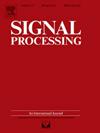Joint design of transmit and receive array window functions via polynomial factorization
IF 3.4
2区 工程技术
Q2 ENGINEERING, ELECTRICAL & ELECTRONIC
引用次数: 0
Abstract
Window functions are commonly used to balance the mainlobe width and sidelobe levels in beamforming applications. Traditionally, windows are selected independently for the transmit (Tx) and receive (Rx) side. However, in active systems like radar, medical ultrasound, and sonar, the same array may operate in both modes, and the convolution of the Tx and Rx windows determines the effective two-way response. Therefore, without jointly designing the Tx/Rx windows, the mainlobe and sidelobe characteristics do not fully benefit from the possibilities of a consolidated two-way approach. This paper presents a framework for jointly designing Tx/Rx window functions by factorization of any desired two-way effective aperture into separate Tx/Rx windows. To guide this factorization, we introduce the white noise gain product (WNGP), a metric quantifying the combined spatial filtering efficiency of the Tx/Rx pair. We then propose a root-allocation strategy for the factorization that maximizes this metric, enabling effective control over the two-way beampattern. Additionally, we derive a recursive formula for the optimal Tx/Rx windows that yield a uniform effective aperture. The approach is validated through simulations, showing improved sidelobe control and greater design flexibility compared to conventional windowing techniques.
利用多项式分解法联合设计发射与接收阵列窗函数
在波束形成应用中,窗函数通常用于平衡主瓣宽度和副瓣电平。传统上,窗口是分别为发送端(Tx)和接收端(Rx)选择的。然而,在雷达、医用超声和声纳等主动系统中,相同的阵列可以在两种模式下工作,并且Tx和Rx窗口的卷积决定了有效的双向响应。因此,如果没有联合设计Tx/Rx窗口,主瓣和副瓣特性就不能充分受益于统一双向方法的可能性。本文提出了一种联合设计Tx/Rx窗口函数的框架,该框架将任意期望的双向有效孔径分解为单独的Tx/Rx窗口。为了指导这种分解,我们引入了白噪声增益积(WNGP),这是一种量化Tx/Rx对组合空间滤波效率的度量。然后,我们提出了一种最大化该度量的分解根分配策略,从而实现对双向波束方向的有效控制。此外,我们推导了产生均匀有效孔径的最佳Tx/Rx窗口的递归公式。通过仿真验证了该方法,与传统的开窗技术相比,显示出更好的旁瓣控制和更大的设计灵活性。
本文章由计算机程序翻译,如有差异,请以英文原文为准。
求助全文
约1分钟内获得全文
求助全文
来源期刊

Signal Processing
工程技术-工程:电子与电气
CiteScore
9.20
自引率
9.10%
发文量
309
审稿时长
41 days
期刊介绍:
Signal Processing incorporates all aspects of the theory and practice of signal processing. It features original research work, tutorial and review articles, and accounts of practical developments. It is intended for a rapid dissemination of knowledge and experience to engineers and scientists working in the research, development or practical application of signal processing.
Subject areas covered by the journal include: Signal Theory; Stochastic Processes; Detection and Estimation; Spectral Analysis; Filtering; Signal Processing Systems; Software Developments; Image Processing; Pattern Recognition; Optical Signal Processing; Digital Signal Processing; Multi-dimensional Signal Processing; Communication Signal Processing; Biomedical Signal Processing; Geophysical and Astrophysical Signal Processing; Earth Resources Signal Processing; Acoustic and Vibration Signal Processing; Data Processing; Remote Sensing; Signal Processing Technology; Radar Signal Processing; Sonar Signal Processing; Industrial Applications; New Applications.
 求助内容:
求助内容: 应助结果提醒方式:
应助结果提醒方式:


